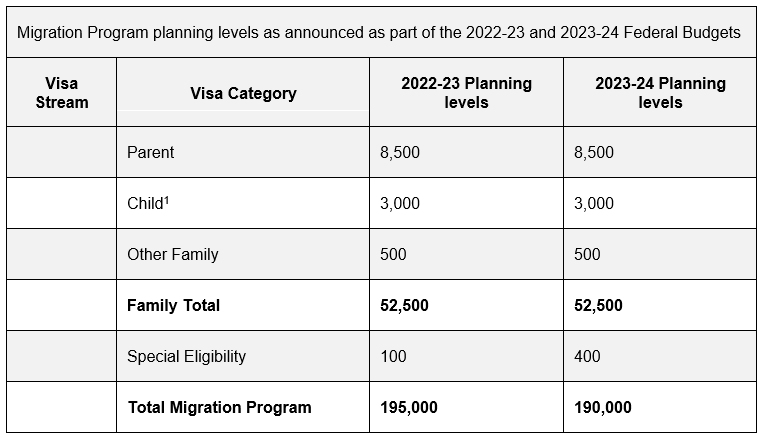2023-24 Migration Program Updates
- Worldlink

- May 8, 2023
- 4 min read
On 9 May 2023, the Australian Government announced that the planning level for the 2023-24 permanent Migration Program will be set at 190,000 places.
The 2023-24 Migration Program has been designed to address persistent and emerging skills shortages and support the transition to a net-zero emissions economy by attracting specialist skillsets that are difficult to find or develop in Australia. The Program has the following composition:
Skill stream (137,100 places) – this stream is designed to improve the productive capacity of the economy and fill skill shortages in the labour market, including those in regional Australia.
Family stream (52,500 places) – this stream is predominantly made up of Partner visas, enabling Australians to reunite with family members from overseas and provide them with pathways to citizenship. Of this stream:
40,500 Partner visas are estimated for 2023-24 for planning purposes, noting this category is demand driven and not subject to a ceiling.
3,000 Child visas are estimated for 2023-24 for planning purposes, noting this category is demand driven and not subject to a ceiling.
Special Eligibility stream (400 places) – this stream covers visas for those in special circumstances, including permanent residents returning to Australia after a period overseas.


For further information on the 2023-24 Migration Program, please see Frequently Asked Questions (319KB PDF).
The Australian government has announced key changes to the Migration Program after the recent Australian budget announcement on 9 May 2023 which are as follows:
a) The Australian government will reduce the complexity of migration subclasses to help simplify the visa application process, allowing people to easily apply for the required visa without waiting for long processing timeframe. Currently, there are around 100 visa subclasses, which is overly complex and its operation opaque.
b) The Australian government will adopt principles and guardrails to manage risk in temporary skilled migration. There will be a division of the Australia Migration System into 3 categories, which are:
Ø Highly skilled workers with higher salary.
Ø Skilled workers with a middle income and help deal with labour shortages effectively;
Ø Reserved for low earning workers essential for various sectors, e.g. aged care, health industry
c) A new points test system will be implemented so that people who are capable of contributing to the economy in the long run are selected. The current points test system used to select skilled migrants without an existing job offer is not designed to identify applicants with the best potential to contribute to Australia over the long term.
d) The Australia government has announced that it will increase Visa Application Charges(VACs) between 6% to 40% from 1 July 2023. The increased visa charges are expected to raise the government AUD100 million in 2023–24 and AUD665 million over five years.
The Visa Application Charge will increase 6% for most visa subclasses , 15% for selected visitor and temporary visa subclasses (including visitor, working holiday, training, temporary activity and temporary work (short stay specialist) and 40% increase for BIIP visas.
A visitor 600 visa application fee, which affects tourists, will increase by AUD40.00, sending the cost up from AUD150.00 to AUD190.00, while a student subclass 500 visa application fee, which impacts international students, will be increased by AUD65.00, from AUD650.00 to AUD715.00.
And a working holiday visa, which will affect backpackers, will be raised by AUD130.00 from AUD510.00 to AUD640.00.
Only the Pacific Engagement Visa and Pacific Australia Labour Mobility scheme visas will be exempt from the increases, according to the budget paper.
e) In an effort to ease Australia’s workforce shortages during the Covid-19 pandemic, the federal government has removed student visa work restrictions, allowing them to work over the usual 40 hours per fortnight. These restrictions will be re-introduced from 1 July 2023 and capped at an increased rate of 48 hours per fortnight. However, students working in the aged-care sector will be exempted from the cap until the end of 2023.
f) The changes to the Australian migration system includes providing faster pathways to permanent residency for skilled graduates. To do this, the Australian government plans to create simpler pathways for international students going on to graduate visas as a way to retain Talented International student. Applicants will therefore spend less time on bridging visas waiting for their substantive visas to be processed.
g) Temporary Graduate (subclass 485) visa holders with select degree will be eligible for an extra 2 years of post-study work rights. From 1 July 2023, some holders of subclass 485 Temporary Graduate visas will be allowed to stay in Australia for a longer period, with the implementation of an extra 2 years of post-study work rights. This is to improve the pipeline of skilled labour in key sectors (with effective 1 July 2023).
The change will result in a stay period of:
four years for a bachelor’s degree graduate, up from two years previously
five years for a master’s degree graduate, up from three years previously
six years for a doctoral graduate, up from four years previously.
h) Restrictions will be removed to enable TSS visa holders on the short-term stream access to permanent residence pathways through the Employer Nomination Scheme (subclass 186) visa. The government will also remove the limit of one onshore renewal for the short-term stream TSS visa.
i) The Australian government will reset the income threshold in a bid to attract more skilled migrants who complement the skills of the Australian workforce. To attain this objective, the government will increase the Temporary Skilled Migration Income Threshold (TSMIT) from the current rate of $53,900 to $70,000 with effective 1 July 2023.

Comments